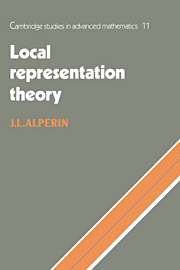 Local Representation Theory
Local Representation Theory Published online by Cambridge University Press: 12 January 2010
Simple modules and simple algebras give a great deal of information about arbitrary algebras and their modules and it is this point that we shall develop in this chapter. Semisimple modules are the key idea. They provide a quick proof of the celebrated Wedderburn theorem on simple algebras and they show how any module can be viewed as consisting of many layers of semisimple modules. Our main interest is group algebras and we shall see quickly how these general results lead to insights about group representations.
Let us establish some fixed notation. We let A be a finite-dimensional algebra with unit element over an algebraically closed field k whose characteristic is p. All A-modules are assumed to be left modules and finite-dimensional over k. We also fix a finite group G and let kG be the group algebra of G over k. When we refer to p-groups or p-subgroups of G we shall be implicitly assuming that p is a prime.
Simple modules
There is a close connection between the structure of A and the structure of A-modules. Certainly the most important A-module is A itself with the module structure given by left multiplication. Moreover, if U is any A-module and u1, …, un are generators for U (for example, a basis of U over k) then U is a homomorphic image of the A-module A ⊕ … ⊕ A, the direct sum of n copies of A, via the map which sends the n-tuple (a1 …, an) to a1u1 + … + anun, as is easily verified.
To save this book to your Kindle, first ensure [email protected] is added to your Approved Personal Document E-mail List under your Personal Document Settings on the Manage Your Content and Devices page of your Amazon account. Then enter the ‘name’ part of your Kindle email address below. Find out more about saving to your Kindle.
Note you can select to save to either the @free.kindle.com or @kindle.com variations. ‘@free.kindle.com’ emails are free but can only be saved to your device when it is connected to wi-fi. ‘@kindle.com’ emails can be delivered even when you are not connected to wi-fi, but note that service fees apply.
Find out more about the Kindle Personal Document Service.
To save content items to your account, please confirm that you agree to abide by our usage policies. If this is the first time you use this feature, you will be asked to authorise Cambridge Core to connect with your account. Find out more about saving content to Dropbox.
To save content items to your account, please confirm that you agree to abide by our usage policies. If this is the first time you use this feature, you will be asked to authorise Cambridge Core to connect with your account. Find out more about saving content to Google Drive.